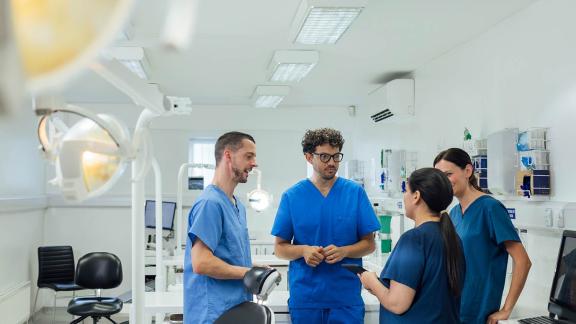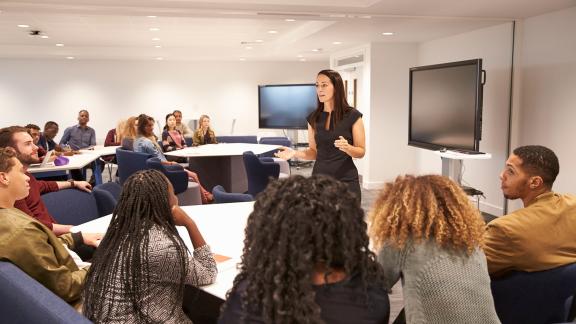Improving the experience of LEDs

Introduction
In 2008, University Hospitals Birmingham (UHB) NHS Foundation Trust initiated a LED programme designed to provide training and clinical experience in various medical and surgical specialties. The trust has also implemented efficient and forward-thinking recruitment practices along with an effective support structure for LEDs throughout their employment.
Key benefits
- Improved administrative efficient and reduced reliance on locums, leading to reduce costs.
- Ensured better and more consistent medical cover, improving patient safety.
- Provided IMGs with a good grounding for their future careers.
- Improved retention and ability to 'train your own' specialists - particularly in hard to fill areas through SAS and CESR.
What the organisation faced
UHB’s primary motivation for focusing on LEDs was to provide consistently high levels of patient safety. As it began to see the number of LEDs steadily increasing, the trust recognised the need to ensure that this segment of the workforce was appropriately skilled and supported to perform their roles effectively.
The trust also acknowledged the difficulty of recruiting for certain specialties, particularly at senior levels.
What the organisation did
Initial buy in was sought from trust executives with the goal of improving patient safety and reducing locum costs being the driving factor.
The trust put in place an LED strategic group alongside an administrative and education team to support the LED workforce both before and after they join the trust.
This collaborative approach ensures a unified approach to the LED programme and enables the organisation to focus exclusively on this group of doctors who, often have different needs compared to other staff groups.
The trust also focused on recruitment, onboarding and training and education to achieve its goals.
Results and benefits
Funding to support this work has been achieved through reduced locum spend and more efficient administrative practices, such as eliminating repeat interviews through offering longer contracts. Cost savings from these measures have largely covered the investment in the LED workforce and, in some cases, led to an overall reduction in spending. In the worst-case scenario, the result is cost neutrality with increased staffing levels ensuring optimal patient safety.
The LED handbook and additional support provided upon employment has proven particularly beneficial to IMGs, who may face additional challenges when adjusting to new working and living environments. This not only ensures greater patient safety but provides additional security to the IMGs themselves.
The e-portfolio has provided an overview of training progression, helping to identify trainees who may be struggling so the trust can provide additional support. Furthermore, doctors applying for training rotations can use e-portfolio evidence to support their applications, facilitating a smoother transition into rotational training posts by providing a comparable resource.
The annual one-day conference hosted for LED and specialty and specialist (SAS) doctors has provided a platform to acknowledge the contributions of these groups of doctors. Additionally, the conference offers LEDs a chance to present quality improvement projects (QIP), an opportunity they might not have otherwise. This can be particularly beneficial for those seeking entry into deanery training programmes.
By supporting LEDs who wish to develop their skills with the trust, such as by the portfolio pathway route the trust has been able to recruit into more senior roles in hard to fill posts. This not only allows the trust to recruit to these roles but ensures greater patients safety by appointees have prior experience working with UHB.
Overcoming challenges
Some initial challenges the trust faced in meeting its goals included securing buy-in from specialties, particularly with regards to aligning contractual conditions with those in training posts and addressing concerns about the potential impact on traditional training posts.
The team worked diligently to shift perceptions from viewing these as non-training posts to recognising them as resident doctors needing professional development. They advocated for the importance of supporting LED development and highlighted the potential benefits to the organisation of doing so.
Research indicates that the referral rate for IMGs is significantly higher in their first year, so using an e-portfolio help mitigate this risk by providing feedback and an educational record of clinical skills from various sources, which can help prevent bias. Additionally, e-portfolios offer reassurance that LEDs can practice safely by providing evidence from multiple sources throughout their employment with the trust.
To better support IMGs, both with adjusting to work in the NHS and life in the UK, the trust developed an induction pack and provides a comprehensive induction period for new IMGs. This provides them not only with additional support at work but helps them adjust to living in the UK by providing relevant information on the local area.
Takeaway tips
- Engage early with stakeholders in order to achieve the necessary support for the work.
- Base local contracts on the 2016 TCS to ensure parity of terms, particularly where LEDs are working alongside doctors in training.
- Start to move away from the perception of LED posts as 'service only' and recognise the need these doctors have for support and development.
- For larger LED cohorts, a specific LED team will allow greater focus on this staff group which is better placed to respond to their specific needs.
- Give additional consideration to the additional support IMGs will need when working in the NHS for the first time; this should include both professional and holistic support to help them settle into living in the UK.
Contact Details
Dr Umesh Salanke - Consultant Emergency Medicine and AMD for Postgraduate Medical Education (LED & SAS).
Kate Shields - Senior Recruitment Manager.
We would love to hear other examples of approaches to employing LEDs.
If you would like to share the work your organisation is doing please contact us.



